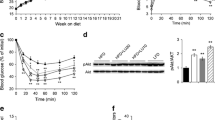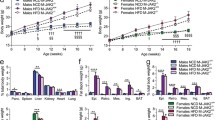Abstract
Aims/hypothesis
Inflammatory factors secreted by macrophages play an important role in obesity-related insulin resistance. Being at the crossroads of a nutrient–hormonal signalling network, the mammalian target of rapamycin complex 1 (mTORC1) controls important functions in the regulation of energy balance and peripheral metabolism. However, the role of macrophage mTORC1 in insulin resistance is still unclear. In the current study, we investigated the physiological role of macrophage mTORC1 in regulating inflammation and insulin sensitivity.
Methods
We generated mice deficient in the regulatory associated protein of mTOR (Raptor) in macrophages, by crossing Raptor (also known as Rptor) floxed mice (Raptor flox/flox) with mice expressing Cre recombinase under the control of the Lysm-Cre promoter (Mac-Raptor KO). We fed mice chow or high-fat diet (HFD) and assessed insulin sensitivity in liver, muscle and adipose tissue. Subsequently, we measured inflammatory gene expression in liver and adipose tissue and investigated the role of Raptor deficiency in the regulation of inflammatory responses in peritoneal macrophages from HFD-fed mice or in palmitic acid-stimulated bone marrow-derived macrophages (BMDMs).
Results
Mac-Raptor KO mice fed HFD had improved systemic insulin sensitivity compared with Raptor flox/flox mice. Macrophage Raptor deficiency reduced inflammatory gene expression in liver and adipose tissue, fatty liver and adipose tissue macrophage content in response to HFD. In peritoneal macrophages from mice fed with an HFD for 12 weeks, macrophage Raptor deficiency decreased inflammatory gene expression, through attenuation of the inactivation of Akt and subsequent inhibition of the inositol-requiring element 1α/clun NH2-terminal kinase–nuclear factor kappa-light-chain-enhancer of activated B cells (IRE1α/JNK/NFκB) pathways. Similarly, mTOR inhibition as a result of Raptor deficiency or rapamycin treatment decreased palmitic acid-induced inflammatory gene expression in BMDMs in vitro.
Conclusions/interpretation
The disruption of mTORC1 signalling in macrophages protects mice against inflammation and insulin resistance potentially by inhibiting HFD- and palmitic acid-induced IRE1α/JNK/NFκB pathway activation.









Similar content being viewed by others
Abbreviations
- ATF6:
-
Activating transcription factor 6
- ATM:
-
Adipose tissue macrophage
- BMDM:
-
Bone marrow-derived macrophage
- CD:
-
Chow diet
- ConA:
-
Concanavalin A
- DIO:
-
Diet-induced obesity
- eIF2α:
-
Eukaryotic translation initiation factor 2α
- ER:
-
Endoplasmic reticulum
- HFD:
-
High-fat diet
- IPGTT:
-
Intraperitoneal glucose tolerance test
- IPITT:
-
Intraperitoneal insulin tolerance test
- IRE1α:
-
Inositol-requiring element 1α
- JNK:
-
cJun NH2-terminal kinase
- mTORC1/2:
-
Mammalian target of rapamycin complex 1/2
- NF-κB:
-
Nuclear factor κB
- NMR:
-
Nuclear magnetic resonance
- PERK:
-
RNA-dependent protein kinase-like ER kinase
- p70S6k:
-
p70 S6 kinase
- Raptor:
-
Regulatory associated protein of mTOR
- SFA:
-
Saturated fatty acid
- TG:
-
Triacylglycerol
- TLR:
-
Toll-like receptor
- UPR:
-
Unfolded protein response
- WAT:
-
White adipose tissue
- XBP1:
-
X box binding protein 1
References
Hotamisligil GS, Shargill NS, Spiegelman BM (1993) Adipose expression of tumor necrosis factor-alpha: direct role in obesity-linked insulin resistance. Science 259:87–91
Flegal KM, Graubard BI, Williamson DF, Gail MH (2007) Cause-specific excess deaths associated with underweight, overweight, and obesity. JAMA 298:2028–2037
Ozcan U, Cao Q, Yilmaz E et al (2004) Endoplasmic reticulum stress links obesity, insulin action, and type 2 diabetes. Science 306:457–461
Park SW, Zhou Y, Lee J et al (2010) The regulatory subunits of PI3K, p85alpha and p85beta, interact with XBP-1 and increase its nuclear translocation. Nat Med 16:429–437
Ozcan L, Ergin AS, Lu A et al (2009) Endoplasmic reticulum stress plays a central role in development of leptin resistance. Cell Metab 9:35–51
Obstfeld AE, Sugaru E, Thearle M et al (2010) C-C chemokine receptor 2 (CCR2) regulates the hepatic recruitment of myeloid cells that promote obesity-induced hepatic steatosis. Diabetes 59:916–925
Qatanani M, Lazar MA (2007) Mechanisms of obesity-associated insulin resistance: many choices on the menu. Genes Dev 21:1443–1455
Weisberg SP, McCann D, Desai M, Rosenbaum M, Leibel RL, Ferrante AW Jr (2003) Obesity is associated with macrophage accumulation in adipose tissue. J Clin Invest 112:1796–1808
Han MS, Jung DY, Morel C et al (2013) JNK expression by macrophages promotes obesity-induced insulin resistance and inflammation. Science 339:218–222
Solinas G, Vilcu C, Neels JG et al (2007) JNK1 in hematopoietically derived cells contributes to diet-induced inflammation and insulin resistance without affecting obesity. Cell Metab 6:386–397
Boden G (2002) Interaction between free fatty acids and glucose metabolism. Curr Opin Clin Nutr Metab Care 5:545–549
Nguyen MT, Favelyukis S, Nguyen AK et al (2007) A subpopulation of macrophages infiltrates hypertrophic adipose tissue and is activated by free fatty acids via Toll-like receptors 2 and 4 and JNK-dependent pathways. J Biol Chem 282:35279–35292
Seimon TA, Nadolski MJ, Liao X et al (2010) Atherogenic lipids and lipoproteins trigger CD36-TLR2-dependent apoptosis in macrophages undergoing endoplasmic reticulum stress. Cell Metab 12:467–482
Erbay E, Babaev VR, Mayers JR et al (2009) Reducing endoplasmic reticulum stress through a macrophage lipid chaperone alleviates atherosclerosis. Nat Med 15:1383–1391
Kapahi P, Chen D, Rogers AN et al (2010) With TOR, less is more: a key role for the conserved nutrient-sensing TOR pathway in aging. Cell Metab 11:453–465
Wullschleger S, Loewith R, Hall MN (2006) TOR signaling in growth and metabolism. Cell 124:471–484
Ozcan U, Ozcan L, Yilmaz E et al (2008) Loss of the tuberous sclerosis complex tumor suppressors triggers the unfolded protein response to regulate insulin signaling and apoptosis. Mol Cell 29:541–551
Ai D, Baez JM, Jiang H et al (2012) Activation of ER stress and mTORC1 suppresses hepatic sortilin-1 levels in obese mice. J Clin Invest 122:1677–1687
Hotamisligil GS (2010) Endoplasmic reticulum stress and the inflammatory basis of metabolic disease. Cell 140:900–917
Jakubzick C, Bogunovic M, Bonito AJ, Kuan EL, Merad M, Randolph GJ (2008) Lymph-migrating, tissue-derived dendritic cells are minor constituents within steady-state lymph nodes. J Exp Med 205:2839–2850
Manning BD (2004) Balancing Akt with S6K: implications for both metabolic diseases and tumorigenesis. J Cell Biol 167:399–403
Tremblay F, Brule S, Hee Um S et al (2007) Identification of IRS-1 Ser-1101 as a target of S6K1 in nutrient- and obesity-induced insulin resistance. Proc Natl Acad Sci U S A 104:14056–14061
Lumeng CN, Bodzin JL, Saltiel AR (2007) Obesity induces a phenotypic switch in adipose tissue macrophage polarization. J Clin Invest 117:175–184
Byles V, Covarrubias AJ, Ben-Sahra I et al (2013) The TSC-mTOR pathway regulates macrophage polarization. Nat Commun 4:2834
Zhang HH, Lipovsky AI, Dibble CC, Sahin M, Manning BD (2006) S6K1 regulates GSK3 under conditions of mTOR-dependent feedback inhibition of Akt. Mol Cell 24:185–197
Kim JK (2006) Fat uses a TOLL-road to connect inflammation and diabetes. Cell Metab 4:417–419
Shi H, Kokoeva MV, Inouye K, Tzameli I, Yin H, Flier JS (2006) TLR4 links innate immunity and fatty acid-induced insulin resistance. J Clin Invest 116:3015–3025
Sabio G, Davis RJ (2010) cJun NH2-terminal kinase 1 (JNK1): roles in metabolic regulation of insulin resistance. Trends Biochem Sci 35:490–496
Laplante M, Sabatini DM (2009) mTOR signaling at a glance. J Cell Sci 122:3589–3594
Weichhart T, Costantino G, Poglitsch M et al (2008) The TSC-mTOR signaling pathway regulates the innate inflammatory response. Immunity 29:565–577
Weichhart T, Haidinger M, Katholnig K et al (2011) Inhibition of mTOR blocks the anti-inflammatory effects of glucocorticoids in myeloid immune cells. Blood 117:4273–4283
Katholnig K, Kaltenecker CC, Hayakawa H et al (2013) p38alpha senses environmental stress to control innate immune responses via mechanistic target of rapamycin. J Immunol 190:1519–1527
Weichhart T, Saemann MD (2009) The multiple facets of mTOR in immunity. Trends Immunol 30:218–226
Sarbassov DD, Ali SM, Sengupta S et al (2006) Prolonged rapamycin treatment inhibits mTORC2 assembly and Akt/PKB. Mol Cell 22:159–168
Hu P, Han Z, Couvillon AD, Kaufman RJ, Exton JH (2006) Autocrine tumor necrosis factor alpha links endoplasmic reticulum stress to the membrane death receptor pathway through IRE1alpha-mediated NF-kappaB activation and down-regulation of TRAF2 expression. Mol Cell Biol 26:3071–3084
Kato H, Nakajima S, Saito Y, Takahashi S, Katoh R, Kitamura M (2012) mTORC1 serves ER stress-triggered apoptosis via selective activation of the IRE1-JNK pathway. Cell Death Differ 19:310–320
Hetz C, Bernasconi P, Fisher J et al (2006) Proapoptotic BAX and BAK modulate the unfolded protein response by a direct interaction with IRE1alpha. Science 312:572–576
Gardai SJ, Hildeman DA, Frankel SK et al (2004) Phosphorylation of Bax Ser184 by Akt regulates its activity and apoptosis in neutrophils. J Biol Chem 279:21085–21095
Zeng L, Liu YP, Sha H, Chen H, Qi L, Smith JA (2010) XBP-1 couples endoplasmic reticulum stress to augmented IFN-beta induction via a cis-acting enhancer in macrophages. J Immunol 185:2324–2330
Martinon F, Chen X, Lee AH, Glimcher LH (2010) TLR activation of the transcription factor XBP1 regulates innate immune responses in macrophages. Nat Immunol 11:411–418
Chen WQ, Zhong L, Zhang L et al (2009) Oral rapamycin attenuates inflammation and enhances stability of atherosclerotic plaques in rabbits independent of serum lipid levels. Br J Pharmacol 156:941–951
Lamming DW, Ye L, Katajisto P et al (2012) Rapamycin-induced insulin resistance is mediated by mTORC2 loss and uncoupled from longevity. Science 335:1638–1643
Ai D, Chen C, Han S et al (2012) Regulation of hepatic LDL receptors by mTORC1 and PCSK9 in mice. J Clin Invest 122:1262–1270
Acknowledgements
The authors would like to thank A. Tall, Columbia University, New York, NY, USA, for his advice and help on experimental design and manuscript writing.
Funding
DA is supported by the National Natural Science Foundation of China (Nos 81322006 and 81370396). YZ is supported by the Major National Basic Research Grant of China (No. 2010CB912504). MW is supported by The Netherlands Organization of Scientific Research (NWO VENI – grant 916.11.072).
Duality of interest
The authors declare that there is no duality of interest associated with this manuscript.
Contribution statement
HJ contributed to the concept and design, data acquisition, analysis and interpretation and drafting of the article. MW contributed to the concept and design, data acquisition and revision of the article. CW and YZ contributed to the data acquisition and analysis and revision of the article. DA contributed to the concept and design, data acquisition, analysis and interpretation of data and revision of the article. DA is the guarantor of the work. All authors approved the final version.
Author information
Authors and Affiliations
Corresponding author
Electronic supplementary material
Below is the link to the electronic supplementary material.
ESM Fig. 1
(PDF 163 kb)
ESM Fig. 2
(PDF 366 kb)
ESM Methods
(PDF 86 kb)
Rights and permissions
About this article
Cite this article
Jiang, H., Westerterp, M., Wang, C. et al. Macrophage mTORC1 disruption reduces inflammation and insulin resistance in obese mice. Diabetologia 57, 2393–2404 (2014). https://doi.org/10.1007/s00125-014-3350-5
Received:
Accepted:
Published:
Issue Date:
DOI: https://doi.org/10.1007/s00125-014-3350-5




